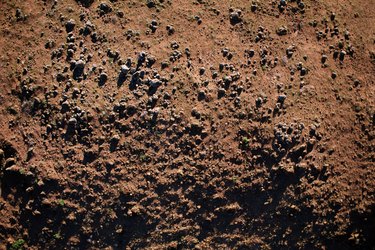
Whether you enjoy getting your hands dirty in the garden or want to learn more about dirt for another reason, the first step is understanding the six different layers of soil. Soil is a natural resource because it has agricultural productivity benefits. Soil takes hundreds to thousands of years to form and contains organic and inorganic materials.
Why Is Soil So Important?
Video of the Day
Soil is essential for life for several reasons. It is the primary medium for plant growth, and plants are the most important source of food on Earth. Not only does soil support roots but it also delivers nutrients and minerals and protects plants from destructive chemical, physical and biological events and activities. On top of all those things, soil also stores and delivers water.
Video of the Day
Soils also maintain atmospheric gas balances; they regulate atmospheric carbon dioxide by storing it. This regulation occurs through the process of humification, where soil organisms form complex, stable organic matter that leads to higher carbon content within the soil. Soils also store oxides and nitrogen and cycle them back into the ground.
Excess stormwater infiltrates the soil, which filters out contaminants. This filtering is essential after heavy rains and snowmelts, as it provides humans and plants with clean water. Soil also serves as a home for minute single-cell organisms known as microbes along with insects and other small creatures. Many of these residents and other visitors, like reptiles, lay and hatch eggs there. Soil supports biodiversity in these ways, and its air and moisture also aid with the decomposition of organic matter.
The Six Layers of Soil
There are many kinds of soil, each with its own unique characteristics. Most types of soil have one thing in common: They have several layers that are also known as horizons. The best way to remember all six is coming up with a mnemonic using the letters O, A, E, B, C and R. Together, they create soil profiles. Some have all the layers, and others do not.
The top O layer stands for organic or humus. This layer can be thick, thin or not present at all, and it includes materials like decomposing leaves. Beneath that is the A topsoil layer. Here you find minerals from parent material with decaying organic matter in it. Topsoil can range from brown to gray and usually contains sand, clay, silt or loam. This layer is where seeds germinate and roots grow; it is particularly vulnerable to wind and water erosion.
The eluviated, or E, level can be missing, and it usually occurs in areas like forests and older soils. It is a thin layer with minerals like clay, aluminum and organic compounds leached out. The E layer mainly consists of sand and silt once the minerals have dripped down through it.
The Lower Three Layers
Beneath the E level is the B level, or subsoil. This fourth layer is where all those minerals from the E level accumulate; it is also called the illuviation zone. It is lighter in color and can appear as a rust or tan color. You won't find much organic matter here, but you will find tree roots. This layer is where the most extensive tree roots end.
Dig deeper and you will arrive at the C layer. This layer is also called regolith, or parent material, and plant roots do not penetrate it. It has next to no organic matter and contains cemented geological material and compacted sediment. Layer C appears gray with fragments of bedrock in it. You don't see much activity here, but there may be the occasional loss or addition of minerals and certain other soluble compounds.
At the bottom is the sixth layer of soil, R, colloquially known as bedrock. It is not soil at all; R is a mass of rock. It can be made of sandstone, limestone, quartzite, basalt, granite or other bedrock. When it is close enough to the soil surface, it can form the parent material.